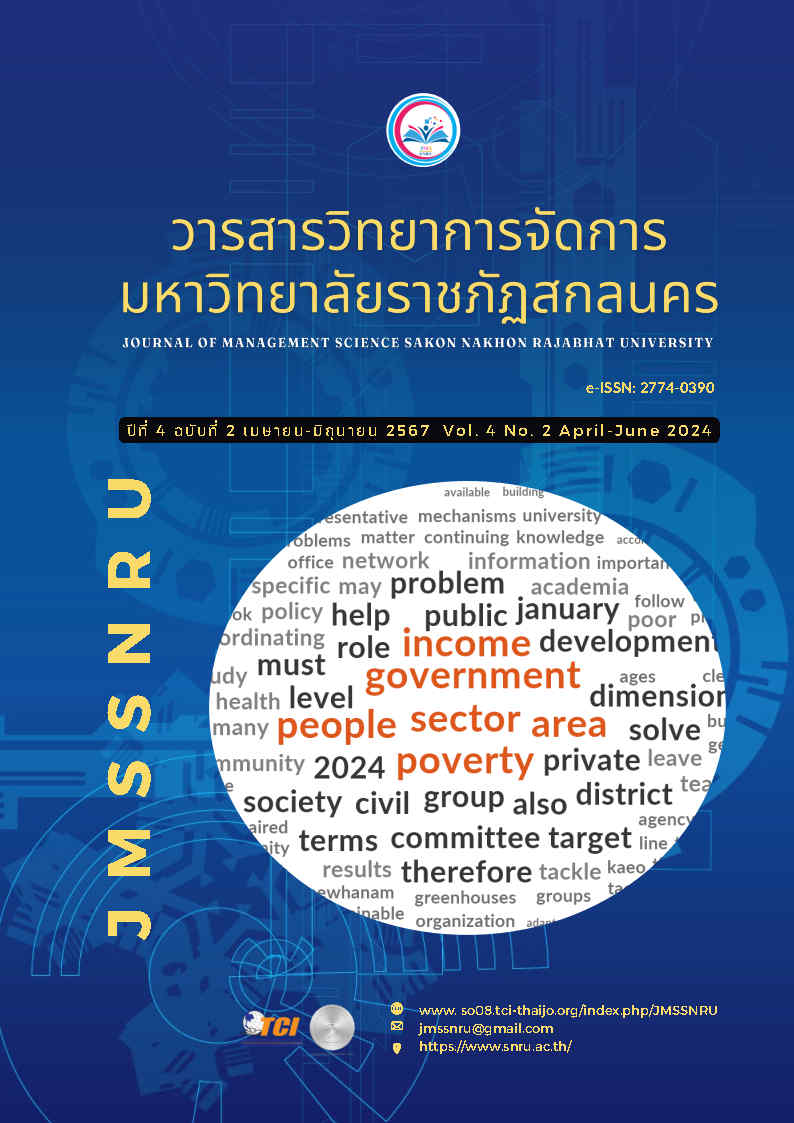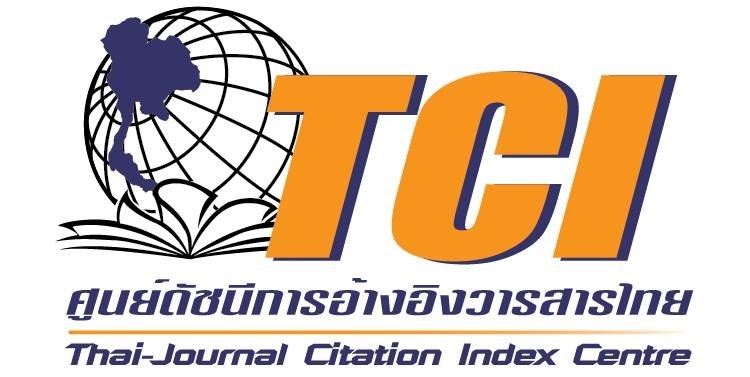การศึกษาอิทธิพลของส่วนประสมทางการตลาดที่มีต่อทัศนคติของผู้บริโภคเกี่ยวกับแอปพลิเคชันในสมาร์ทโฟน ธนาคารไทยพาณิชย์ จำกัด (มหาชน) ในจังหวัดอุดรธานี
คำสำคัญ:
ทัศนคติของผู้บริโภค, ธนาคารทางโทรศัพท์, ส่วนประสมการตลาด, แอพลิเคชันในสมาร์ทโฟนบทคัดย่อ
วัตถุประสงค์ของบทความนี้ คือการตรวจสอบอิทธิพลที่เป็นไปได้ของบริการธนาคารบนมือถือ (M Banking) ที่มีต่อทัศนคติของลูกค้า กล่าวคือเป็นการศึกษาอิทธิพลของส่วนประสมทางการตลาดที่มีต่อทัศนคติของผู้บริโภคเกี่ยวกับแอปพลิเคชันในสมาร์ทโฟน ธนาคารไทยพาณิชย์ จำกัด (มหาชน) ในจังหวัดอุดรธานี การเก็บรวบรวมข้อมูลโดยการสำรวจลูกค้าธนาคาร 420 คน ซึ่งสุ่มตัวอย่างโดยแบบสองขั้นตอน เทคนิคการสร้างแบบจำลองการถดถอยนำมาใช้ในการวิเคราะห์แบบจำลองแนวคิดและทดสอบชุดสมมติฐานวิจัย ผลการวิเคราะห์ข้อมูลแสดงให้เห็นว่าส่วนประสมการตลาดอิเล็กทรอนิกส์เป็นตัวทำนายที่แข็งแกร่งเกี่ยวกับทัศนคติของลูกค้าที่มีต่อธนาคารทางโทรศัพท์กล่าวคือ ปัจจัยส่วนประสมทางการตลาดด้านพนักงานปัจจัยส่วนประสมทางการตลาดด้านกายภาพ และปัจจัยส่วนประสมทางการตลาดด้านกระบวนการที่มีต่อทัศนคติของผู้บริโภค
เอกสารอ้างอิง
วรรณพร หวลมานพ. (2558). พฤติกรรมและความพึงพอใจของผู้ใช้แอพพลิเคชั่นเคโมบายแบงก์กิ้งพลัสของธนาคารกสิกรไทย จำกัด (มหาชน) ในเขตกรุงเทพมหานคร. วารสารศาสตรมหาบัณฑิต สาขาวิชาการบริหาร สื่อสารมวลชน คณะวารสารศาสตร์และสื่อสารมวลชน มหาวิทยาลัยธรรมศาสตร์.
Bitner, M.J. (1992). Services capes: the impact of physical surroundings on customers and employees. The Journal of Marketing. 56(2), 57-71.
Bolton, R.N. & Drew, J.H. (1991). A multistage model of customers’ assessments of service quality and value. Journal of Consumer Research. 17(4), 375-384.
Chang, H.H. & Chen, W.S. (2008). The impact of online store environment cues on purchase intention: trust and perceived risk as a mediator. Online Information Review. 32(6), 818-841.
Ciunova-Shuleska, A., Palamidovska-Sterjadovska, N., Prodanova, J., (2022). What drives m-banking clients to continue using m-banking services? Journal of Business Research, 139, 731–739.
Eroglu, S.A., Machleit, K.A. & Davis, L.M. (2003). Empirical testing of a model of online store atmospherics and shopper responses. Psychology & Marketing. 20(2), 139-150.
Gronroos, C. (1990), Service Management and Marketing, Lexington Books, Lexington, MA.
Gronroos, C. (2001). The perceived service quality concept – a mistake. Managing Service Quality, 119(3), 150-2
Harris, L.C. & Goode, M.H. (2010). Online servicescapes, trust, and purchase intentions. Journal of Services Marketing, 24(3), 230-243.
Hopkins, C.D., Grove, S.J., Raymond, M.A. and LaForge, M.C. (2009), “Designing the e-servicescape: implications for online retailers. Journal of Internet Commerce, 8(12), 23-43.
Kang, G-D. & James, J. (2001). Service quality dimensions: an examination of Gronroos’s service quality model. Managing Service Quality, 14(4), 266–277.
Karjaluoto, H., Mattila, M. and Pento, T. (2002). Factors underlying attitude formation towards online banking in Finland. International Journal of Banking Marketing, 20(6), 261-72.
Laforet, S. & Li, X. (2005). Consumers’ attitudes towards online and mobile banking in China. International Journal of Bank Marketing, 23(5), 362-380.
Lin, H.F. (2011). An empirical investigation of mobile banking adoption: the effect of innovation attributes and knowledge-based trust. International Journal of Information Management, 31(3), 252–260.
Moutinho, L. & Smith, A. (2000). Modelling bank customer satisfaction through mediation of attitudes towards human and automated banking. International Journal of Bank Marketing, 18(3), 124-134.
Pal, A., Herath, T., De, R., Rao, H.R. (2021). Why do people use mobile payment technologies and why would they continue? An examination and implications from India. Research Policy. 50, 104228.
Parasuraman, A. & Grewal, D. (2000). The impact of technology on the quality-value-loyalty chain: a research agenda. Journal of the Academy of Marketing Science, 28(1), 168-174.
Parasuraman, A., Zeithaml, V.A. and Malhotra, A. (2005), “ES-QUAL: a multiple-item scale for assessing electronic service quality. Journal of Service Research, 7(3), 213-233.
Parasuraman, A., Zeithaml, Valarie A., & Berry, Leonard L. (1988). SERVQUAL: A multiple-item scale for measuring consumer perceptions of service quality. Journal of Retailing, 64, 12–37.
Sahoo, D. & Pillai, S.S. (2017). Role of mobile banking service escape on customer attitude and engagement: An empirical investigation in India. International Journal of Bank Marketing, 35(7), 1115-1132.
Shankar, A., Jebarajakirthy, C., Ashaduz zaman, M., (2020). How do electronic word of mouth practices contribute to mobile banking adoption. Journal of Retail and Consumer Service, 52, 1–14.
Sharma, M., Banerjee, S., & Paul, J. (2022). Role of social media on mobile banking adoption among consumers. Technological Forecasting & Social Change. 180, 121720.
ดาวน์โหลด
เผยแพร่แล้ว
รูปแบบการอ้างอิง
ฉบับ
ประเภทบทความ
สัญญาอนุญาต
ลิขสิทธิ์ (c) 2024 วารสารวิทยาการจัดการ มหาวิทยาลัยราชภัฏสกลนคร

อนุญาตภายใต้เงื่อนไข Creative Commons Attribution-NonCommercial 4.0 International License.
บทความที่ตีพิมพ์ในวารสารวิทยาการจัดการ มหาวิทยาลัยราชภัฏสกลนคร เป็นทัศนะ ลิขสิทธิ์ และความรับผิดชอบของผู้เขียนเจ้าของผลงาน






